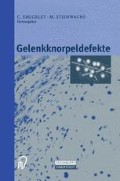Zusammenfassung
Der Bedarf für neue therapeutische Ansätze zur Behandlung von Knorpelund Knochendefekten nimmt mit der wachsenden Zahl an Patienten mit degenerativen Erkrankungen des Skelettsystems, wie z. B. der Arthrose, stetig zu. Vielversprechende neue Technologien bietet das Tissue Engineering durch die Transplantation funktionell aktiver autologer Zellen, den Einsatz von morphogenen Wachstumsfaktoren und formgebender oder temporär stützender Biomaterialien. Mit Hilfe dieser Technologie solI neues Knorpelund Knochengewebe aufgebaut bzw. das pathologisch veränderte Gewebe regeneriert werden.
Access this chapter
Tax calculation will be finalised at checkout
Purchases are for personal use only
Preview
Unable to display preview. Download preview PDF.
Literatur
Redlich A, Perka C, Schultz O, Spitzer R, Häupl T, Burmester GR, Sittinger M.: Bone engineering on the basis of periosteal cells cultured in polymer fleeces. J Mat Sci (in press)
Perka C, Schultz 0, Spitzer R, Lindenhayn K, Burmester G, Sittinger M: Segmental Bone Repair by Tissue Engineered Periosteal Cell Transplants with Different Bioresorbable Carriers in Rabbits. Biomaterials (in press)
Perka C, Schultz O, Spitzer R, Lindenhayn K: The influence of transforming growth factor N1 on mesenchymal cell repair of full-thickness cartilage defects (submitted)
Kaps C, Hoffmann A, Czichos S, Tzylanowski P, Sittinger M, Häupl T, Huylebroeck D, Gross G, Gazit D: BMP-receptor-IA (BMPR-IA, Alk3) and not the BMPreceptor-IB (BMPR-IB, Alk6) mediates the BMP-2 dependent chondro-/osteogenic differentiation potential in mesenchymal progenitors C3H10T1/2. J Bone Min Res (submitted)
Gruber R, Sittinger M, Bujia J (1996) Untersuchungen zur in vitro Kultivierung von Humanchondrozyten bei Einsatz FCS-freier Zuchtmedien. Minimierung des möglichen Risikos einer Infektion mit Erregern von Prionen-Erkrankungen. Laryngo-Rhino Otol 75:105–108
Sittinger M, Bräunling J, Kastenbauer E, Hammer C, Burmester G, Bujia J (1997) Untersuchungen zum Vermehrungspotential von Nasenseptum-Chondrozyten für die in-vitro Züchtung von Knorpeltransplantaten. Laryngo-Rhino Otol 76:96–100
Kreklau B, Sittinger M, Mensing M, Voigt C, Berger G, Burmester G-R, Rahmanzadeh R, Gross U (1999) Tissue Engineering of Biphasic Joint Cartilage Transplants. Biomaterials 20:1743–1749
Rotter N, Sittinger M, Hammer C, Bujia J, Kastenbauer E (1997) Transplantation in vitro hergestellter Knorpelmaterialien: Charakterisierung der Matrixsynthese. Laryngo-Rhino Otol 76:241–247
Haisch Rathert T, Jahnke V, Burmester GR, Sittinger M (1997) In vitro engineered cartilage for auricular reconstruction. Advances in Tissue Engineering and Biomaterials, York
Freed LE, Grande DA, Lingbin Z, Emmanuel J, Marquis JC, Langer R (1994) Joint resurfacing using allograft chondrocytes and synthetic biodegradable polymer scaffolds. J Biomed Mat Res 28:891–899
Perka C, Schultz O, Lindenhayn K, Spitzer RS, Muschik M, Sittinger M, Burmester GR: Joint cartilage repair with transplantation of embryonic chondrocytes embedded in collagen-fibrin-matrices. Clin Exp Rheum (in press)
Ma PX, Langer R (1999) Morphology and mechanical function of long-term in vitro engineered cartilage. J Biomed Mater Res 44:217–221
Endres M (1999) Untersuchung biomechanischer Eigenschaften von in vitro hergestellten Knorpeltransplantaten. Diplomarbeit Biotechnologie, Thesis, TFh Berlin
Bujia J, Alsalameh S, Naumann A, Wilmes E, Sittinger M, Burmester GR (1994) Humoral immune response against minor collagens type IX and XI in patients suffering from cartilage graft resorption after reconstructive surgery. Ann Rheum Dis 53:229–234
Sittinger M, Jerez R, Burmester G-R, Krafft T, Spitzer W (1996) Antibodies to collagens in sera from patients receiving bovine cartilage grafts. Ann Rheum Dis 55:333–334
Goldring MB, Birkhead J, Sandell LJ, Kimura T, Krane SM (1988) Interleukin 1 suppresses expression of cartilage-specific types II and IX collagens and increases types I and III collagens in human chondrocytes. J Clin Invest 82:2026–2037
Campbell IK, Piccoli DS, Butler DM, Singleton DK, Hamilton JA (1988) Recombinant human interleukin-1 stimulates human articular cartilage to undergo resorption and human chondrocytes to produce both tissue-and urokinase-type plasminogen activator. Biochim Biophys Acta 967:183–194
Luyten FP, Chen P, Paralkar V, Reddi AH (1994) Recombinant bone morphogenetic protein-4, transforming growth factor-beta 1, and activin A enhance the cartilage phenotype of articular chondrocytes in vitro. Exp Cell Res 210:224–229
Kaps C, Rathert T, Bramlage C, Haisch A, Ungethüm U, Sittinger M, Burmester G-R, Gross G, Häupl T: Bone morphogenetic proteins promote cartilage differentiation and protect engineered artificial cartilage from fibroblast invasion. Arthritis & Rheumatism (submitted)
Schultz O, Keyszer G, Zacher J, Sittinger M, Burmester G-R (1997) Development of in vitro model systems for destructive joint diseases. Novel strategies to establish inflammatory pannus. Arthritis and Rheumatism 40:1420–1429
Editor information
Editors and Affiliations
Rights and permissions
Copyright information
© 2001 Springer-Verlag Berlin Heidelberg
About this chapter
Cite this chapter
Sittinger, M. (2001). Tissue Engineering. In: Erggelet, C., Steinwachs, M. (eds) Gelenkknorpeldefekte. Steinkopff, Heidelberg. https://doi.org/10.1007/978-3-642-57716-1_3
Download citation
DOI: https://doi.org/10.1007/978-3-642-57716-1_3
Publisher Name: Steinkopff, Heidelberg
Print ISBN: 978-3-7985-1265-8
Online ISBN: 978-3-642-57716-1
eBook Packages: Springer Book Archive

